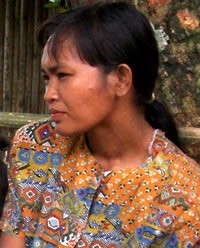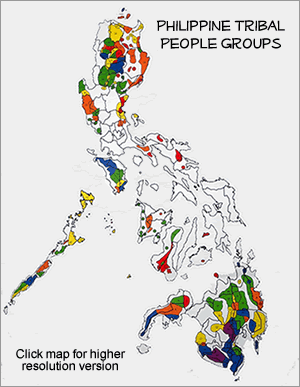The Ati is a Negrito ethnic group of the Philippines. They are genetically-related [2] to other Negrito ethnic groups in the Philippines such as the Aeta of Luzon, the Batak of Palawan, and the Mamanwa of Mindanao.
In the Philippines the Aetas or Ati ancestors were the 'aboriginals' or the 'first' inhabitants of this Archipelago. They most probably arrived from Borneo 20-30,000 years ago, through what is thought to be an isthmus (today what remains of that is the island of Palawan) that in the prehistoric epoch connected the Philippine archipelago to Borneo via a land bridge. [3] According to some oral traditions, they also pre-date the Bisaya, who now inhabit most of the Visayas. Legends, such as those involving the Ten Bornean Datus and the Binirayan Festival, tell tales about how, at the beginning of the XII century, the ancestors of the Bisaya escaped from Borneo from the persecution of Rajah Makatunaw. Led by Datu Puti and Datu Sumakwel and sailing with boats called balangay, they landed near a river called Suaragan, on the southwest coast of Panay, (the place then known as Aninipay), and bartered the land from an Ati headman named Polpolan and his son Marikudo for the price of a necklace and one golden salakot. The hills were left to the Atis while the plains and rivers to the Malays. This meeting is commemorated through the Ati-atihan festival. This legend, though, is challenged by some historians. [4]
During the Spanish colonization, the tribe made contact with the conquistador Legazpi and were made useful in his colonization of Panay.
They live on Panay Island, which is located in the Visayas (Islands of Cebu, Bohol, Siquijor, Leyte, Samar, Panay, Masbate, Negros and Guimaras), the central portion of the Philippine archipelago.
Unlike the Aeta of the north, who speak Sambalic languages, the Ati speak a Visayan language known as Inati. As of 1980, the speakers of Inati number at about 1,500. Today few of them know how to speak Inati and Visaya and Kinary-a are commonly used. [1]
Not too long ago, like other Negritos in the country, their clothing was simple, with women wearing wraparound skirts, sometimes made out of bark cloth, and men wearing loincloths. However today T-shirts, pants, and rubber sandals are common as daily clothes.
Jewelry is simple in nature. Some jewelry objects involve plants such as flowers, while others use animal bones; particularly the teeth of pigs.
Ati are known in Panay as practitioners of herbal medicine. Locals often seek their help in removing leeches from a person's body.
The Aetas traditionally were nomadic people, with the Aetas (Ati) of Panay being known as the most mobile. Now they lived in more permanent settlements like Barotac Vejo, island of Guimaras, Igkaputol (Dao), Tina (Hamtic) and Badiang (San Jose de Buenavista. The famous island of Boracay is still regarded as their ancestral land as the area kown as Takbuyan, between the municipalities of Tobias Fournier (Dao) and San Joaquin, on the southwestern coast of Panay. Very few of them are now nomadic (mostly women with small children). Ati men traditionally join 'sacadas' workers on time of harvest of sugar plants in places such Negros or Batangas.
The Ati are the central attraction in the Ati-atihan festival, a festival named in their honor. It is said that the festival is held to commemorate the first appearance of the Roman Catholic Church and the Spaniards in the province of Aklan. According to oral tradition, the Ati helped the Spaniards conquer the native Bisaya and, as a reward, the tribe was given a statue of the Santo Niño.
In the Dinagyang festival of Iloilo City, also on Panay, performers are also painted to look supposedly like Ati and are organized into "tribes", called "tribus", to perform dances with drums, as the Atis are supposed to have done when the Malay arrived and bought Panay from the Ati. Dinagyang is held to celebrate this purchase as well as the arrival in Iloilo of the Santo Niño statue. When the statue first arrived in 1967, a tribe from the Ati-atihan festival was invited to Iloilo to mark the occasion.
The Ati practice a form of animism that involves good and evil spirits. These spirits are nature spirits that often guard rivers, the sea, the sky, as well as the mountains. Sometimes, they may cause disease or comfort. The Ati from Negros refer to them as taglugar or tagapuyo, which literally means "inhabiting a place." Christianity has also been adopted due to less isolation and more contact with "outsiders".
Currently, the tribe is threatened due to encroachments into their territory, recently seen in Boracay. Another problem they face is discrimination.
Pray for spiritual growth for the Christian believers among the Ati.
Pray that the Ati will be treated with dignity and respect.
Pray that their territory will be protected and preserved for their use.
Pray that their lives will be marked by true peace and joy.
Scripture Prayers for the Negrito, Ati in Philippines.
:
1. "Ati - A language of Philippines". Ethnologue. http://www.ethnologue.com/show_language.asp?code=atk. Retrieved 2007-03-26.
2. "image from rafonda.com". rafonda.com. http://www.rafonda.com/assets/images/fig.2.3.542pop.jpg. Retrieved 2007-03-27.
| Profile Source: Wikipedia / Joshua Project Creative Commons |











